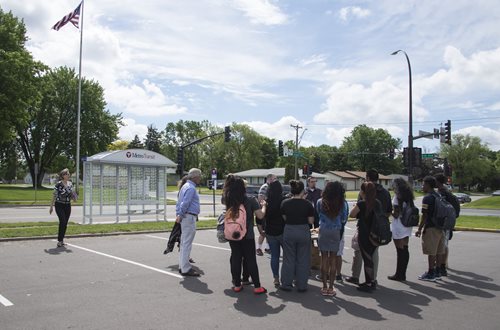Enhancing access to opportunity in areas of concentrated poverty

Marvin Applewhite has a knack for connecting with people. He made an impact when the Corcoran Neighborhood Organization was surveying and talking with people for a Metro Transit initiative called Better Bus Stops.
Marvin and Brettina Davis, an organizer for the neighborhood organization, engaged people at nine different locations, primarily along Lake Street. As people walked by, the duo would ask them to take a survey about how bus stops and shelters could be improved. Young or old, Marvin could draw in even reluctant passers-by for a conversation.
“Our front porch to our customers is the bus stop. That’s where we present ourselves to our customers really for the first time.”
– Brian Lamb, Metro Transit General Manager
“I like to be part of something positive,” Marvin said. “We had a ball—it was a lot of fun.”
Corcoran Neighborhood Organization was one of 11 community groups that surveyed residents and heard their stories about how to improve and where to place bus shelters.
“Data is important, but when you can align that with lived experience, lived outcomes, you get much better-informed decision-making,” said Repa Mekha, president and CEO of Nexus Community Partners.

Improving the customer experience
The goal of the Better Bus Stops project is to enhance access to opportunity by investing in bus stop shelters, lighting, heat and pedestrian access. Metro Transit is adding up to 150 shelters and improving an additional 75 existing shelters with light or heat.
In addition, Metro Transit recently acquired more than 200 privately owned advertising shelters. Many are on high-ridership routes, are 30 years old and in poor condition. Metro Transit is replacing them with new shelters, or has removed those that did not meet the criteria for shelter replacement.
To engage residents in influencing the criteria and to learn what their experiences are with bus stops and shelters, Metro Transit initiated a robust community process. Active from March 2016 to March 2017, the effort focused on areas of concentrated poverty where more than half of residents are people of color.
WHY FOCUS ON COMMUNITY ENGAGEMENT?
It fosters greater transparency in Metro Transit decision-making and involves the residents that are most likely to be impacted by those decisions.
Metro Transit partnered with the Community Engagement Team (CET), which includes Nexus Community Partners, the Alliance for Metropolitan Stability, and the Center for Urban and Regional Affairs at the University of Minnesota. The CET awarded $217,250 from the Council in contracts to 11 local organizations.
Results
-
New and strengthened relationships between residents and Metro Transit staff and neighborhood groups.
-
Engaged residents—approximately 7,000 people at 200 events, most in communities traditionally underrepresented in transit decisions.
-
Community influence on guidelines for bus-stop investments.
-
Strengthened community capacity by compensating community organizations as full partners.
-
Metro Transit is halfway to its goal to add 150 new shelters.
Better Bus Stops Map
See Metro Transit's map of planned and recent bus stop improvements.
In a related initiative, Metro Transit has replaced and updated its signage at 10,000 bus stops. By the end of 2017, all 12,000 stops will have new signs.
Warmth and humor as tools for engagement
 Marvin was taking a class at Adult Basic Education School on Lake Street in Minneapolis when he first met Brettina. She asked if he and his classmates would be willing to take a survey about bus stops.
Marvin was taking a class at Adult Basic Education School on Lake Street in Minneapolis when he first met Brettina. She asked if he and his classmates would be willing to take a survey about bus stops.
“They talked to us, cracked a few jokes and I was sold,” Marvin said. He filled out a survey, and liked the idea of talking other people into taking it. He left his phone number with Brettina.
“He was really personable, and seemed like a good fit for the project,” Brettina said. They learned Marvin had lived in the neighborhood for a few years, and heard good things about him.
One tool they used was a small erasable whiteboard and a camera. Marvin would ask people to write down what they like best about bus stops or what they would change, and then took their photo. If they were reluctant he would turn on the charm, point to his boss, and say “I’ll be in trouble if you don’t do this,’” he laughed as he recalled it.
Marvin often runs into people now in the neighborhood that he met during the effort, and they reconnect.
“There was some real nice bonding going on out there,” Marvin said. “They felt like they was being heard. [Our humor] made them more engaged with us.”
Effort builds local leadership capacity
The staff at the neighborhood organization was so impressed with Marvin, they asked him to run for a position on their board, and he was voted in. He said he enjoys bringing insight to the board on a variety of issues, including a big development at Lake and Hiawatha. He helps with the Midtown Farmers Market and meets more people there. His engagement with community strengthens his impact in the organization.